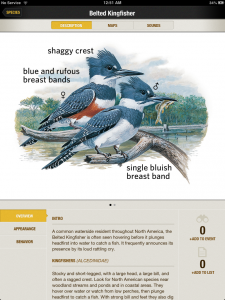2018 School Spending Survey Report
Tweets, Drums, and Warbles: A Digital Field Guide to North American Birds | Touch and Go
The perfect companion on a summer hike? National Geographic's digital guide to North American birds allows nature lovers to identify winged creatures, learn about their habits, and record sightings, all before they can say Ladder-backed Woodpecker.

Interior screen from 'National Geographic Birds: Field Guide to North America'
No longer must fledgling birders juggle a field guide, a journal, and a pen—all they need to do is download the National Geographic Birds: Field Guide to North America (National Geographic/IXONOS $9.99; Gr 4 Up) onto an iPad or iPhone, and voilà, they’re ready to go. The app, like the print version of the guide (2006; Jon L. Dunn and Jonathan Alderfer, eds.), offers an overview of species on our continent (995 here), their appearance and behavior, as well as labeled color images and habitat and range maps. Giving each animal a voice is one of the features listeners are sure to sing about. They'll be able to hear the caterwauling of a pair of Barred Owls, the warble of a Hermit Thrush, and the laugh of a Marbled Godwit, among hundreds of other sounds and songs. When opening the app for the first time, a quick tutorial appears, offering readers everything they need to know to get started. On the trail, users can sort the creatures by name, family, taxonomy, color, size, habitat, month, region, and abundance. Once a bird is spotted and identified, the journal feature allows users to document the sighting, automatically identifying the location, time, date, and weather. Users have the option to add notes and/or a photo and share the event. They can also create their own lists of feathered animals to remember or can follow one of National Geographic’s lists, such as the "Birder’s Wish List” or “Favorite Backyard Birds.” There are quizzes of various levels to take, more than two dozen up-to-date news articles about various species to read, and a toolkit that includes a glossary, information on gear and “birding ethics,” and 16 short videos. Whether visiting a park, forest, meadow, the shore, or just sitting in their backyard watching winged wildlife, viewers are sure to appreciate this extraordinary guide.—Elizabeth Kahn, Patrick F. Taylor Science & Technology Academy, Jefferson, LARELATED
RECOMMENDED
CAREERS
The job outlook in 2030: Librarians will be in demand
CAREERS
The job outlook in 2030: Librarians will be in demand
ALREADY A SUBSCRIBER? LOG IN
We are currently offering this content for free. Sign up now to activate your personal profile, where you can save articles for future viewing






Add Comment :-
Be the first reader to comment.
Comment Policy:
Comment should not be empty !!!